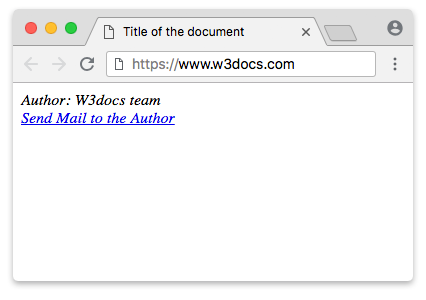The <address> tag is used to provide contact information about the owner of sites or the author of the article. It can contain email, phone, address, link to the site, and so on.
Syntax
The <address> tag comes in pairs. The content is written between the opening (<address>) and closing (</address>) tags.
Most browsers add a line break before the element and after it, and the information in the tag is displayed in italic.
If the <address> tag is placed inside the
element, the contact information it contains refers to the entire document as a whole. To specify the contact information of the author of the article, you must place the <address> tag inside the <article> element.Example of the HTML <address> tag:
<!DOCTYPE html>
<html>
<head>
<title>Title of the document</title>
</head>
<body>
<address>
Author: W3docs team<br />
<a href="mailto:[email protected]">Contact Author</a>
</address>
</body>
</html>Result

The <address> tag is included together with other information in the <footer> element.
Example of the HTML <address> tag with the HTML <footer> tag:
<!DOCTYPE html>
<html>
<head>
<style>
.header{
height: 40px;
padding: 20px 20px 0;
background: #e1e1e1;
}
.main-content{
height: 60vh;
padding: 20px;
}
footer{
padding: 10px 20px;
background: #666666;
color: white;
}
a{
color: #00aaff;
}
</style>
</head>
<body>
<div class="header">Header / Menu</div>
<div class="main-content">
<h1>Main content</h1>
<p>This is some paragraph. </p>
</div>
<footer style="display:flex; justify-content:space-between; align-items:flex-end;">
<p style="margin:0;">Company © W3docs. All rights reserved.</p>
<address>
3rd street, app 43<br />
New York, USA
</address>
</footer>
</body>
</html>Attributes
The <address> tag supports the Global Attributes and the Event Attributes.
How to style <address> tag?
Common properties to alter the visual weight/emphasis/size of text in <address> tag:
- CSS font-style property sets the style of the font. normal | italic | oblique | initial | inherit.
- CSS font-family property specifies a prioritized list of one or more font family names and/or generic family names for the selected element.
- CSS font-size property sets the size of the font.
- CSS font-weight property defines whether the font should be bold or thick.
- CSS text-transform property controls text case and capitalization.
- CSS text-decoration property specifies the decoration added to text, and is a shorthand property for text-decoration-line, text-decoration-color, text-decoration-style.
Coloring text in <address> tag:
- CSS color property describes the color of the text content and text decorations.
- CSS background-color property sets the background color of an element.
Text layout styles for <address> tag:
- CSS text-indent property specifies the indentation of the first line in a text block.
- CSS text-overflow property specifies how overflowed content that is not displayed should be signalled to the user.
- CSS white-space property specifies how white-space inside an element is handled.
- CSS word-break property specifies where the lines should be broken.
Other properties worth looking at for <address> tag:
- CSS text-shadow property adds shadow to text.
- CSS text-align-last property sets the alignment of the last line of the text.
- CSS line-height property specifies the height of a line.
- CSS letter-spacing property defines the spaces between letters/characters in a text.
- CSS word-spacing property sets the spacing between words.
Browser support
|
|
|
|
|
|
|---|---|---|---|---|
| ✓ | ✓ | ✓ | ✓ | ✓ |
Practice Your Knowledge
Quiz Time: Test Your Skills!
Ready to challenge what you've learned? Dive into our interactive quizzes for a deeper understanding and a fun way to reinforce your knowledge.